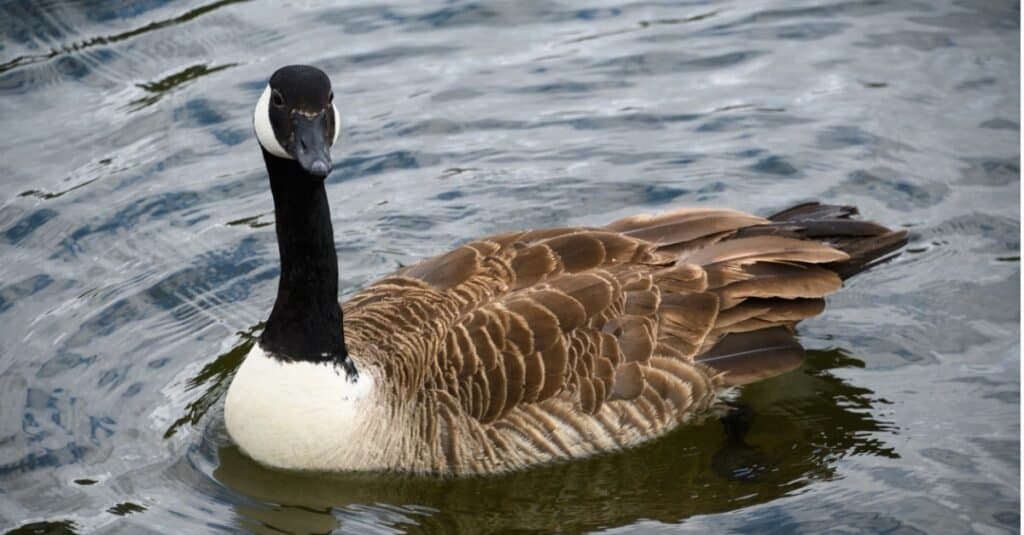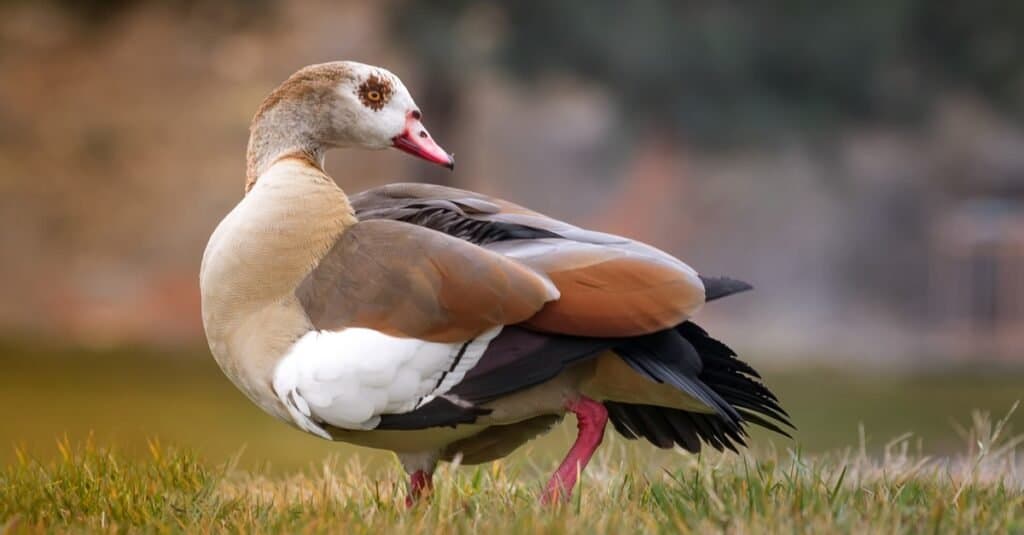The goose is a big, long-necked waterfowl that has earned a fearsome reputation for its repeated attacks on humans (as well as a starring role in the comical video game title “Untitled Goose Game”), but it’s also so much more fascinating than this simplistic caricature suggests: it’s a doting parent, an extreme endurance flier, and a fascinating study of bird anatomy and behavior. It is closely related to the small, short-necked ducks and the graceful, long-necked swans in the family of Anatidae.
But back to those attacks for a moment. Some people have been bitten by geese, and could swear that there were goose teeth in its bill! Is that true? Do geese have teeth? Join us as we learn more about geese, and find out if “goose teeth” really do exist.
Goose Behavior
Geese can be divided into two general groups: the gray geese and white geese from the genus Anser and the black geese from the genus Branta. They are found all over the Northern Hemisphere, from the extreme frigid climates of northern Siberia to the pleasant wind-swept Pacific islands of Hawaii. A separate group called the shelgeese also originates from South America, but these are not generally considered to be true geese, because they’re more duck-like in nature.
The goose’s penchant for loud honking and aggressive action is intensified by their territorial behavior in the mating or nesting season. While this sometimes leads to conflict with people, their intention is actually to protect their young goslings from danger. Geese will also stretch and flap their wings to show their full wingspan in an attempt to become as imposing and physically large as they possibly can. They do this as a part of their aggressive behavior along with a sometimes fearless charge!
When they let loose a warning call, they will often stretch forward, open their mouths, and show off the strange teeth-like projections lining the tongue and beak. Goose teeth actually have a fascinating function that sets them apart from traditional teeth.
But what on earth are they? Are they really goose teeth? This article will cover some important details about what they are, how they’re used, and why they evolved.
Do Geese Have Teeth?
The short answer to this question is that no, geese do not have teeth, at least by any normal definition. True teeth are made from a protective outer coating called enamel. They are then attached to the jaw or the inner mouth via deep roots. While many vertebrates (and even some invertebrates) have some kind of teeth, birds, as a general rule, do not. The only exception to this rule is the egg tooth, located on the upper beak, which helps the young hatchling break through the eggshell. However, the tooth itself is more like a bone covered by a horn, and it’s soon lost immediately after hatching.
What a goose does have instead of true goose teeth are sharp serrated edges called tomia. These differ from true teeth in a few important respects. First, tomia is composed of cartilage rather than enamel; this is essentially the same substance found in joints, ears, noses, and vertebral discs. Cartilage allows for more flexibility than bone, but it is also much harder than the typical soft tissue, which is perfect for gripping and handling food. The second way in which tomia differs from true teeth is that it’s a natural extension of the beak and tongue, inseparable from the surrounding tissue. It isn’t really a separate object like a tooth and cannot be lost.

©Roger Utting/Shutterstock.com
How Do Geese Eat and Digest Their Food?
The goose’s diet consists primarily of grasses, grains, leaves, roots, stems, and other low-lying vegetation. They supplement this with small insects, rodents, or even fish they find while foraging. The tomia (or goose teeth) from the tongue and the beak work together to grip, tear, and uproot food, but it isn’t quite tough enough to chew food into smaller bits. The function of breaking apart food is actually handled by a separate organ called the gizzard, a muscular chamber located near the stomach that reduces organic tissue to smaller, digestible bits. The analogous function in humans would be handled by the molars in the back of the mouth.
The gizzard is composed of many grooves and ridges that contract together to grind up hard food bits such as meat and tough plants before entering the actual stomach. Birds will often swallow pebbles and stones to store in the gizzard and improve its grinding capabilities. Most of the evidence indicates that the evolution of the gizzard was an important adaptation to compensate for the loss of teeth. The gizzard also happens to shift the center of gravity downward toward the body to help make flying much easier.
Why Don’t Geese Have Any Teeth?
Birds, as a whole, lost their teeth at some point during the course of their evolution. There are a few reasons why this occurred. By far the most common and popular theory is that birds lost their teeth to improve their flying ability. The large jaw of the reptilian ancestors was quickly lost as birds evolved the smaller skull and lighter skeletal structure necessary for true flight. When the jaws shrunk, there was no longer any room for the teeth. They evolved gizzards partially to compensate for this.
There’s a second possible theory, though far less accepted. Birds may have lost their teeth to dramatically reduce their incubation times. It’s estimated that the development of the teeth requires some 60% of the incubation period alone. This leaves the egg particularly vulnerable to predators and natural threats. Once the birds lost their teeth, however, they could hatch in only a few days. This may mean they can start foraging far sooner as well.
Based on fossil evidence, the loss of teeth happened very early on in the bird’s evolution. The very first avians evolved from dinosaurs in the Late Jurassic Period, some 150 million years ago, and retained both teeth and claws from their recent reptilian ancestors. Birds evolved most of their modern features during the Cretaceous Period between 145 million and 66 million years ago. This is when they gradually lost their teeth and gained the ability for more powerful, sustained flight. Shortly after the massive extinction event some 66 million years ago, the early ancestors of modern waterfowl began to arise, probably with some form of tomia already having evolved.

©Yavuz Alhan/Shutterstock.com
Does a goose bite hurt?
The short answer to that question is that yes, a goose bite would probably hurt. While the tomia don’t have the capacity to cut very deeply, those “goose teeth” are pretty hard and could potentially draw blood and maybe even do quite a bit of damage. Geese are highly territorial birds in the nesting season and seem to treat almost everyone as a potential threat. If they feel threatened in any way, then they will charge, flutter, or fly at people with wings extended. The most important thing you can do to avoid a goose attack is to give them lots of space and avoid provoking them in any way. You should also avoid the temptation to feed them because this encourages them to approach people. But as long as you leave them alone, they will usually try to mind their own business.
Up Next:
- Goose Lifespan: How Long Do Geese Live? Yes, geese have a long wingspan, but what about their lifespan?
- Duck vs Goose: 5 Key Differences for These Birds! Duck, duck, duck, goose! But who really knows the difference? Read to find out the key differences.
- Swan Teeth: Do Swans Have Teeth? Now you know about geese, but what about the graceful swan?
The photo featured at the top of this post is © Bildagentur Zoonar GmbH/Shutterstock.com
Thank you for reading! Have some feedback for us? Contact the AZ Animals editorial team.






